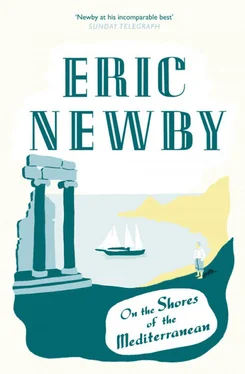1 Under the cassa integrazione 70–80 per cent of what a worker would normally earn is paid by agreement between the employer, employee and the state.
2 It is said that in one year, 1978, 500,000 bottles of imitation Fernet Branca were seized by the customs at Naples alone.
3 San Gennaro’s blood is first said to have liquefied in the hands of the sainted Bishop Severus on the occasion when the body was first translated from Pozzuoli to Naples at the time of Constantine. The first documented liquefaction took place in the Abbey of Montevergine on 17 August 1389.
The miracle repeats itself three times a year: on the first Saturday in May, when the two phials are taken in procession to the great, bare convent church of Santa Chiara in Spaccanapoli, and on 19 September and 16 December in the Cappella del Tesoro of the Cathedral, on all three occasions before enormous audiences.
During the autumn following our Neapolitan excursion we laid what plans we could for our clockwise journey round the Mediterranean, which, thanks to Wanda telling me to get on with it and plunging me into Naples instead of going off and sitting on top of the Rock of Gibraltar and feeling imperial, had started before it was intended to.
That winter we set off for Chioggia, a fishing port at the southern end of the Venetian Lagoon, about twenty miles south of Venice, a place that is picturesque enough in summer but in winter can look a bit pinched and poverty-stricken and has extremely draughty side-streets. It is also noted for having inhabitants who are extremely difficult for an outsider ever to get to know. Here, worn down by the efforts of trying to hire a boat for a private trip to Venice at a price we could afford from monoglot Chioggiotti who see quite enough of polyglot visitors such as ourselves for eight months of the year without being pestered by them during the other four, we decided to leave their austere but strangely attractive city – in which by far the jolliest place is the fish market – by public transport. In summer we could have gone the whole way by steamer, but because this was the dead season there was no direct service and we would have to travel first by boat across the Porto di Chioggia, the southernmost of the entrances to the Lagoon, to the Litorale di Pellestrina, one of the three elongated, offshore dunes which together form the Venetian Lagoon and at the same time protect it from the fury of the Adriatic, and from there take a No. 11 bus along the Litorale to Porto di Malamocco, the entrance to the Lagoon which now takes all the biggest ships, where it is driven on to a ferry and taken across to the Litorale di Lido to continue its journey to Piazzale Santa Maria Elisabetta, where one can take a No. 11 vaporetto across the Lagoon to Venice. Nothing to it, really.
Although we had failed in our dealings with the Chioggiotti, it would have been easier, if we had been really pushed, to do a deal with them than with the Veneziani, who have a tariff for everything and with whom there is no possibility of bargaining, something a lot of other representatives of Christendom discovered back at the time of the Fourth Crusade on their way to the Holy Land.
At the last moment before the Venetian fleet, which the Crusaders had booked in 1202 to take them to the scene of the action, was due to sail with them on board, from their assembly point on the Litorale di Lido, some of their commanders found themselves unable to meet their commitments to the Veneziani who, although there were fewer Crusaders than had been originally contracted for, still insisted on being paid, according to the tariff, the full passage money for those who had not turned up.
This deadlock was only resolved when the Doge Enrico Dandolo, who in spite of being nearly ninety and almost blind was leading the expedition in person, made a deal with their leaders whereby the Venetians would forgo part of the payment in exchange for help while en route in re-taking Zara, one of their ports on the Adriatic, which had gone over to the Hungarians.
But even this was not enough for the Venetians. Once they had reduced this Christian city with the aid of the Crusaders, a campaign that was punished by the Pope excommunicating all the Venetians and all the Crusaders taking part, the Doge then imposed a further condition: that the Crusaders should help the Venetians to storm yet another stronghold of Christendom, the Greek Byzantine city of Constantinople, in order, ostensibly, to restore the Emperor, who had been deposed, but in fact to revenge the death of thousands of Venetians who had been slaughtered there by the Greeks ten years previously, and to make Venice the most influential power in the eastern Mediterranean. The Doge himself led the combined forces against the city in April 1204, breaching the seaward walls and taking it by storm, virtually destroying it and gathering loot of a magnificence that was to make Venice the envy of the world. It also made her – personified by the Doge, who stayed on and eventually died and was buried there – mistress of three-eighths of what was now to become a Latinized city, as well as of Durazzo, on what are now the Albanian shores of the Adriatic, Lacedaemon, otherwise Sparta, the Greek islands of the Cyclades and Sporades, and Crete. The other five-eighths of the city became the property of Count Baldwin, who was crowned as Latin Emperor of the East in what had now become, as Santa Sofia, a Roman Catholic cathedral, as did half the Byzantine territory which lay outside the walls. The other half was given to various Crusader knights, who held it as vassals. Altogether, for the Venetians, it had been a famous victory.
By the time we sailed from Chioggia, the Lagoon, the Litorali, and the Adriatic out beyond them were shrouded in freezing fog, and when we got down at the boat terminus on the Litorale di Pellestrina, which is just opposite the cemetery, and decided to miss the bus connection and take a later one in order to see the murazzi , the sea walls, it was with some regret that we watched its rear lights disappearing into the fog.
The houses in Pellestrina, clustered about a big white church, were a series of rectangles painted in ox-blood, vivid blues and greens and soft greys that rendered them almost invisible in the fog. Closely shuttered against it, as they were, only the drifts of smoke from the strange, tall Venetian chimneys showed that they were inhabited.
Walking amongst them we came to the murazzi , on the seaward side of the Litorale. They had been conceived by a cosmographer, Father Vincenzo Coronelli, in 1716, and work was finally begun on them in 1744 under the direction of Bernardino Zendrini, a mathematician. It took thirty-eight years to complete them at a cost of forty million Venetian gold ducats, and they were the last major works undertaken by the Magistrati delle Acque , the Magistrates of the Waters, who were responsible for building and maintaining the defences of the Lagoon and the city against the Adriatic, before the shameful extinction of this Republic of the Sea by Napoleon in 1797. They replaced previous defences which consisted of wooden palisades that had to be renewed every six years, long groynes extending seawards and musk-smelling tamarisk planted to give stability to what was mostly sand, defences that each winter had been breached and destroyed with monotonous regularity by the sirocco storms. More than 14 feet thick at the base, two and a half miles long, and nearly 20 feet high, they are built of gleaming white blocks of marble, some of them more than 6 feet long and a yard and a half wide, all brought from Istria on the Yugoslavian side of the Adriatic in barges, the same stone used to build so many of the churches in Venice and the Lagoon. Now, ghostly in the fog, they stretched away into it on either side, the only sound the Adriatic sucking at their outer defences, an enormous breakwater of heaped-up boulders.
Читать дальше












